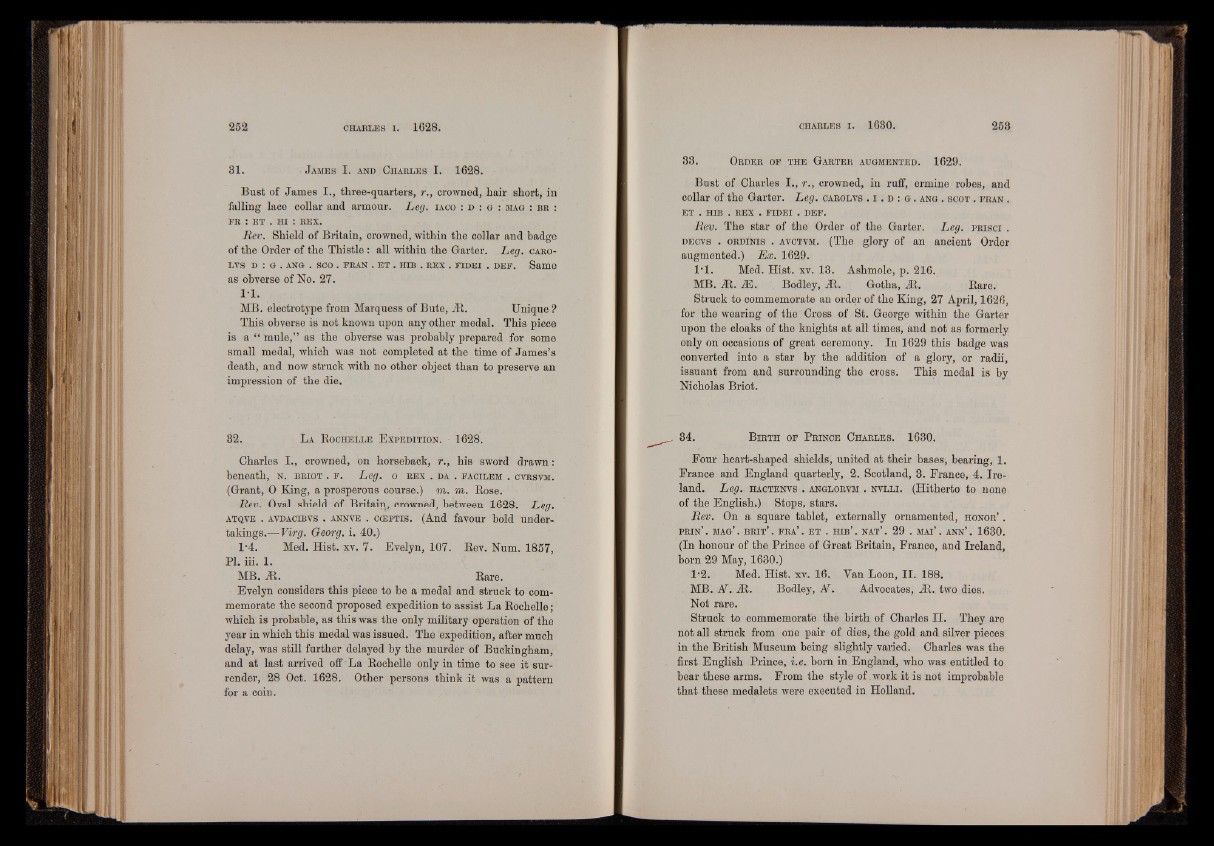
Bust of James I., three-quarters, r., crowned, hair short, in
falling lace collar and armour. Leg. i a c o : d : g : m ag : b r :
FR : ET . HI : REX.
Rev. Shield of Britain, crowned, within the collar and badge
of the Order of the Thistle : all within the Garter. Leg. c a r o -
LVS D : G . ANG . SCO . FRAN . ET . HIB . REX . FIDEI . DEF. S am e
as obverse of No. 27.
1-1.
MB. electrotype from Marquess of Bute, jit. Unique ?
This obverse is not known upon any other medal. This piece
is a “ mule,” as the obverse was probably prepared for some
small medal, which was not completed at the time of James’s
death, and now struck with no other object than to preserve an
impression of the die.
82. La R o c h e l l e E x p e d i t i o n . ■ 1628.
Charles I., crowned, on horseback, r., his sword drawn:
beneath, n . b r i o t . f . Leg. o r e x . d a . f a c i l e m . c v r s vm .
(Grant, 0 King, a prosperous course.) m. m. Rose.
Rev. Oval shield of Britaiq, crowned, between 1628. Leg.
a t q v e . a v d a c ib v s . a n n v e . ccEPTis. (And favour bold undertakings.—
Virg. Georg, i. 40.)
1-4. Med. Hist. xv. 7. Evelyn, 107. Rev. Num. 1857,
PI. iii. 1.
MB. iR. Rare.
Evelyn considers this piece to be a medal and struck to commemorate
the second proposed expedition to assist La Rochelle;
which is probable, as this was the only military operation of the
year in which this medal was issued. The expedition, after much
delay, was still further delayed by the murder of Buckingham,
and at last arrived off'La Rochelle only in time to see it surrender,
28 Oct. 1628. Other persons think it was a pattern
for a coin.
33. O r d e r o f t h e G a r t e r a u g m e n t e d . 1629.
Bust of Charles I., r., crowned, in ruff, ermine robes, and
collar of the Garter. Leg. c a r o l v s . i . d : g . a n g . s c o t . f r a n .
ET . HIB . REX . FIDEI . DEF.
Rev. The star of the Order of the Garter. Leg. p r i s c i .
d e c v s . o r d i n i s . a v c tv m . (The glory of an ancient Order
augmented.) Ex. 1629.
l ’l. Med. Hist. xv. 13. Ashmole, p. 216.
MB. JR. JE. Bodley, JR. Gotha, JR. Rare.
Struck to commemorate an order of the King, 27 April, 1626,
for the wearing of the Cross of St. George within the Garter
upon the cloaks of the knights at all times, and not as formerly
only on occasions of great ceremony. In 1629 this badge was
converted into a star by the addition of a glory, or radii,
issuant from and surrounding the cross. This medal is by
Nicholas Briot.
84. B i r t h o f P r i n c e C h a r l e s . 1630.
Four heart-shaped shields, united at their bases, bearing, 1.
France and England quarterly, 2. Scotland, 3. France, 4. Ireland.
Leg. h a c t e n v s . a n g l o r v m . n v l l i . (Hitherto to none
of the English.) Stops, stars.
Rev. On a square tablet, externally ornamented, h o n o r ’ .
p r i n ’ . m a g ’ . b r i t ’ . f r a ’ . e t . h i b ’ . n a t ’ . 29 . m a i’ . a n n ’ . 1630.
(In honour of the Prince of Great Britain, France, and Ireland,
born 29 May, 1630.)
1*2. Med. Hist. xv. 16. Yan Loon, II. 188.
MB. AT. M. Bodley, M. Advocates, JR.. two dies.
Not rare.
Struck to commemorate the birth of Charles II. They are
not all struck from one pair of dies, the gold and silver pieces
in the British Museum being slightly varied. Charles was the
first English Prince, i.e. born in England, who was entitled to
bear these arms. From the style of work it is not improbable
that these medalets were executed in Holland.